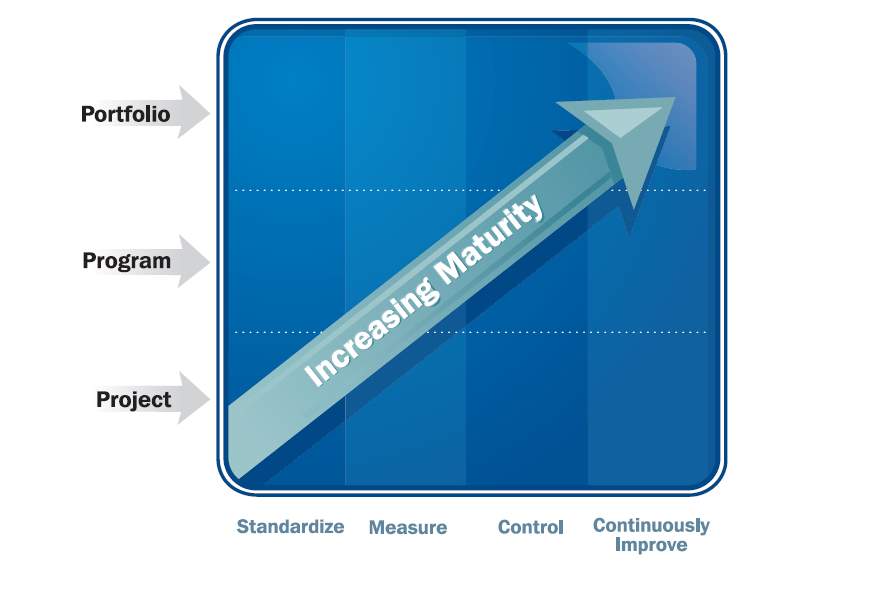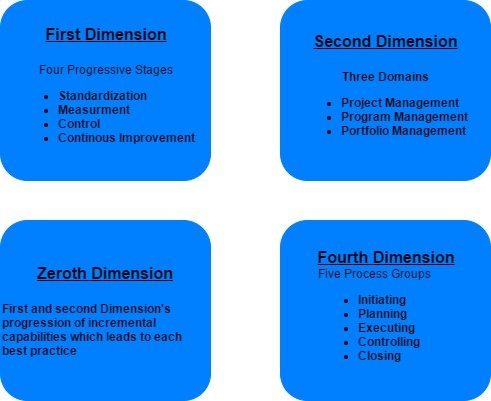The Project Management Institute (PMI) published a standard called Organizational Project Management Maturity Model (OPM3) under the stewardship. For Organizations, the main purpose of the OPM3 standard is to presents an approach to explain an organizational project management and to assess the maturity of the project against a broad-based set of Organizational project management best practices.
Organizational Project Management (OPM) is used to achieve or complete the goals of the Organization by means of projects. Organizational project management is the utilization of skills, techniques, knowledge, and tools to project and organizational activities. In Organizational Project Management Maturity Model (OPM3), the term “Organization” is not limited to an agency, company or society but it applies to a group which is aiming to use their material in the OPM3 standard. It illustrates business strategies and gives regulations and high-level perspective of resources which straightly influence financial consequences of organizations if it is used properly. Overall, OPM is a strategic asset in a competitive economy.
In the case of Organizational Project Management, the “maturity model” is a conceptual network which contains constituent parts that characterize maturity in the area of interest. With the use of OPM3, the maturity model also gives a process which can establish a set of best practices and capabilities. This process makes the organizational state more mature thus it gives the more mature organization. Organizational project management maturity is demonstrated by the consolidation of the best practices within the program, projects and portfolio domains.
The incremental effectiveness that accumulated to best practices is described in the maturity model of OPM, which are also essential to powerful organizational project management. There are several ways and dimensions to assess the organization’s maturity and the progress of increasing maturity using the OPM3. One of these dimensions comprises looking best practices in terms of the cooperation with the progressive stages of process improvement. This process improvement is from standardization to control to measurement which leads to the continuous improvement of the projects of an organization.
As shown in the above figure, the maturity of the organizational project management is increasing along a continuum. The progression of the best practices connected with each of the domains is included in another dimension. This dimension firstly addresses project management, then program management and finally portfolio management.
Organizational Project Management Maturity Model (OPM3) is intentionally developed without any overall system of levels of maturity. If the maturity progress is one dimensional, the development of the specific maturity levels is very straight forward. However, OPM3 is a multi-dimensional. Furthermore, It categorizes the capabilities with their combination with five process groups of the project management. Initiating, Planning, Executing, Controlling, and closing are these process groups which permits the determination of the fourth dimension of maturity.
There are three interlocking elements of the Organizational Project Management Maturity Model (OPM3): Knowledge, Assessment, and Improvement. The user or an organization becomes capable in standards in the knowledge element. It includes the idea of OPM, organizational project management maturity, and methods and concepts of OPM3 to be comfortable with the body of the best practices. In assessment model, it is in a comparison with the standards to find the current place on the continuum of OPM maturity. Finally, in Improvement element, the decision to move forward with some changed initiatives gives increased maturity which can use these results of the assessment for planning and implementation of this plan. Following figure shows the interlocking of the elements of OPM3 with the concept in support of each element.
Organizational Project Management Maturity Model (OPM3) Cycle
The following steps of Organizational Project Management Maturity Model (OPM3) cycle are related with the Knowledge, Assessments and Improvement Concepts.
1. Knowledge
Step 1: Prepare for Assessment
The preparation for the process of assessing the maturity of the organization in relation to the model is the first step for an organization. This preparation includes the thorough understanding the contents of the model, with the operation of the organizational project management maturity model, and becoming aware of the organizational project management.
2. Assessment
Step 2: Perform Assessment
The second step is determining the organization’s maturity in Organizational project management. The comparison of the characteristics of the present maturity state of the model with the characteristics describes in the Organizational Project Management Maturity Model (OPM3). This step includes the review of which best practices are included and are not included in the organization and establish its location on the continuum. Organizations can make their own assessment tool or they can use the tool provided in OPM3. Afterward, the further investigation of the capabilities of the organization is proceeded to in more details to find out the deficiencies which provide the plan of the improvement, repetition of assessment or exit the process as shown in following figure.
3. Improvement
Step 3: Plan for Improvement
To improve the maturity of an organization, the results of the step two will produce the plan of the improvement. This step will rank the required capabilities and outcomes regarding their priority which can give an idea to develop a definite plan to improve and achieve the outcomes related to the capabilities of the best practices.
Step 4: Implement Improvement
The change or modification will take place in this step. The Organization will implement the plan once it is established in the previous step such as execute development activities to achieve the required capabilities and to increase the overall maturity of the Organization.
Step 5: Repeat the process
After completing the improvement activity, the organization will return to the step two to reassess the position of the organization on the continuum of the OPM maturity. Or else, It will return to the improvement step to address other best practices which were identified previously in assessment.



